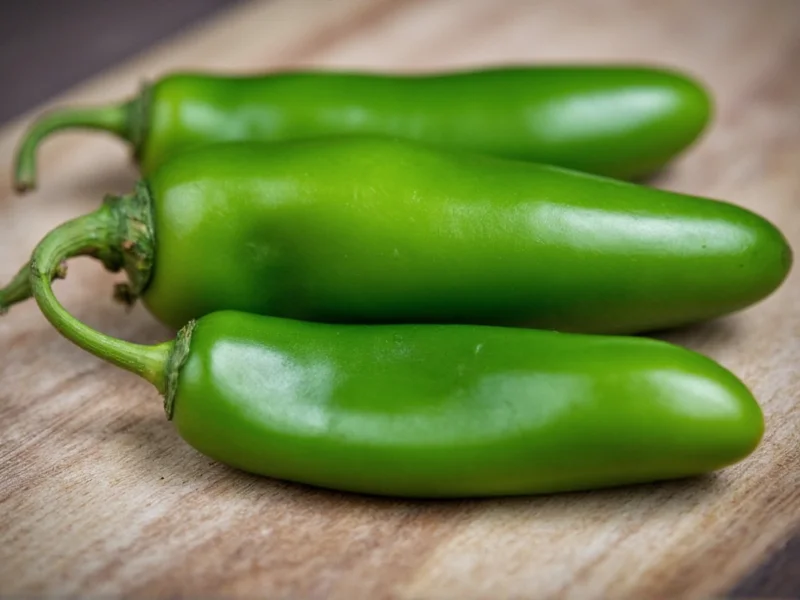When comparing serrano vs jalapeno peppers, understanding their distinct characteristics helps home cooks and culinary professionals make informed choices for their recipes. Both belong to the Capsicum annuum species but differ significantly in heat, flavor, and culinary applications. This comprehensive guide examines every aspect of these popular chili peppers to help you select the right one for your cooking needs.
Heat Level Comparison: Serrano vs Jalapeno
The most significant difference between these peppers is their heat intensity. Understanding the serrano pepper vs jalapeno heat comparison is crucial for recipe planning.
| Pepper Type | Scoville Heat Units (SHU) | Relative Heat | Heat Distribution |
|---|---|---|---|
| Serrano | 10,000-23,000 | 2-9x hotter than jalapeño | Concentrated in placenta/seeds, consistent throughout |
| Jalapeño | 2,500-8,000 | Baseline for comparison | More variable; can have milder specimens |
When determining which is hotter serrano or jalapeno, serranos consistently rank higher on the Scoville scale. A single serrano often matches the heat of multiple jalapeños. The heat in serranos is more consistent across individual peppers, while jalapeños can vary significantly—some may be quite mild while others approach the lower range of serrano heat.
Physical Characteristics and Flavor Profiles
Beyond heat levels, these peppers differ in appearance and taste, making them suitable for different culinary applications.
Appearance Differences
- Serrano peppers: Smaller (1-3 inches), cylindrical shape, smooth thin skin, typically bright green to red when mature
- Jalapeño peppers: Larger (2-4 inches), tapered shape with rounded ends, thicker skin with characteristic striations (corking), green to red when mature
Flavor Comparison
The serrano jalapeno flavor profile comparison reveals distinct taste characteristics:
- Serrano: Bright, grassy, slightly floral with intense heat that comes on quickly. The thinner walls make them less suitable for stuffing but excellent for blending into sauces.
- Jalapeño: More vegetal, slightly sweet with earthy notes. The thicker flesh holds up better to cooking methods like roasting and stuffing.
Culinary Applications: When to Use Each Pepper
Understanding the practical differences helps answer the common question: when to use serrano instead of jalapeno?
Serrano Pepper Best Uses
- Traditional Mexican salsas (especially pico de gallo and salsa verde)
- Hot sauces requiring intense heat without overwhelming volume
- Garnishes where small amounts of heat are needed
- Marinades for meats where quick heat infusion is desired
Jalapeño Pepper Best Uses
- Stuffed peppers (with cream cheese, meats, or cheeses)
- Pickled preparations (popular as "escabeche")
- Rings for burgers, sandwiches, and nachos
- Infused oils and vinegars
- Milder salsas and guacamole
Substitution Guidance: Serrano vs Jalapeno
When considering serrano vs jalapeno substitution in recipes, keep these guidelines in mind:
- Replacing jalapeños with serranos: Use half the amount of serranos to achieve similar heat levels
- Replacing serranos with jalapeños: You may need 2-3 times more jalapeños to match serrano heat
- For stuffed pepper recipes: Jalapeños are superior due to their larger size and thicker walls
- For fresh salsas: Serranos provide more consistent heat but require careful handling
Remember that heat levels can vary within each pepper type based on growing conditions, maturity, and even position on the plant. Always taste a small piece before committing to a recipe.
Growing Characteristics
For home gardeners interested in the differences between serrano and jalapeno peppers cultivation:
- Serrano plants: Grow 24-36 inches tall, produce upright peppers, typically ready for harvest in 70-80 days
- Jalapeño plants: Grow 24-36 inches tall, produce downward-hanging peppers, typically ready in 70-85 days
- Both prefer full sun, well-draining soil, and consistent watering
- Serranos tend to be slightly more challenging to grow in cooler climates
Storage and Preparation Tips
Proper handling ensures you get the best flavor and safety when working with these peppers:
- Store both peppers in the refrigerator's crisper drawer for 1-2 weeks
- For longer storage, freeze whole peppers for up to 6 months
- Always wear gloves when handling serranos due to their higher capsaicin content
- Remove seeds and white membranes (placenta) to reduce heat in both varieties
- Wash hands thoroughly with soap after handling, avoiding contact with eyes
Nutritional Comparison
Both peppers offer similar nutritional benefits with minor variations:
- Excellent source of vitamins C and A
- Contain capsaicin, which may boost metabolism
- Low in calories (about 4-5 calories per pepper)
- Serranos may have slightly higher vitamin C content due to thinner walls
- Both contain antioxidants with potential health benefits
Frequently Asked Questions
Which pepper is hotter, serrano or jalapeño?
Serrano peppers are significantly hotter than jalapeños, typically measuring 10,000-23,000 Scoville Heat Units compared to jalapeños' 2,500-8,000 SHU. A single serrano often provides as much heat as 2-3 jalapeños.
Can I substitute serrano for jalapeño in recipes?
Yes, but use approximately half the amount of serrano peppers to replace jalapeños due to their higher heat level. For stuffed pepper recipes, jalapeños work better because of their larger size and thicker walls.
What's the main flavor difference between serrano and jalapeño?
Serranos have a brighter, grassier flavor with immediate heat, while jalapeños offer a more vegetal, slightly sweet taste with earthy notes. Serranos work best in fresh salsas, while jalapeños excel in stuffed preparations.
How can I reduce the heat of serrano peppers?
To reduce serrano heat, remove all seeds and the white membrane (placenta) inside the pepper, which contains most of the capsaicin. Soaking sliced peppers in salt water for 15-20 minutes can also help mellow the heat.
Which pepper is better for making hot sauce?
Serranos are often preferred for hot sauces requiring intense heat without adding too much volume, while jalapeños work better for milder sauces with more body. Many hot sauce makers blend both peppers to achieve balanced heat and flavor.











 浙公网安备
33010002000092号
浙公网安备
33010002000092号 浙B2-20120091-4
浙B2-20120091-4